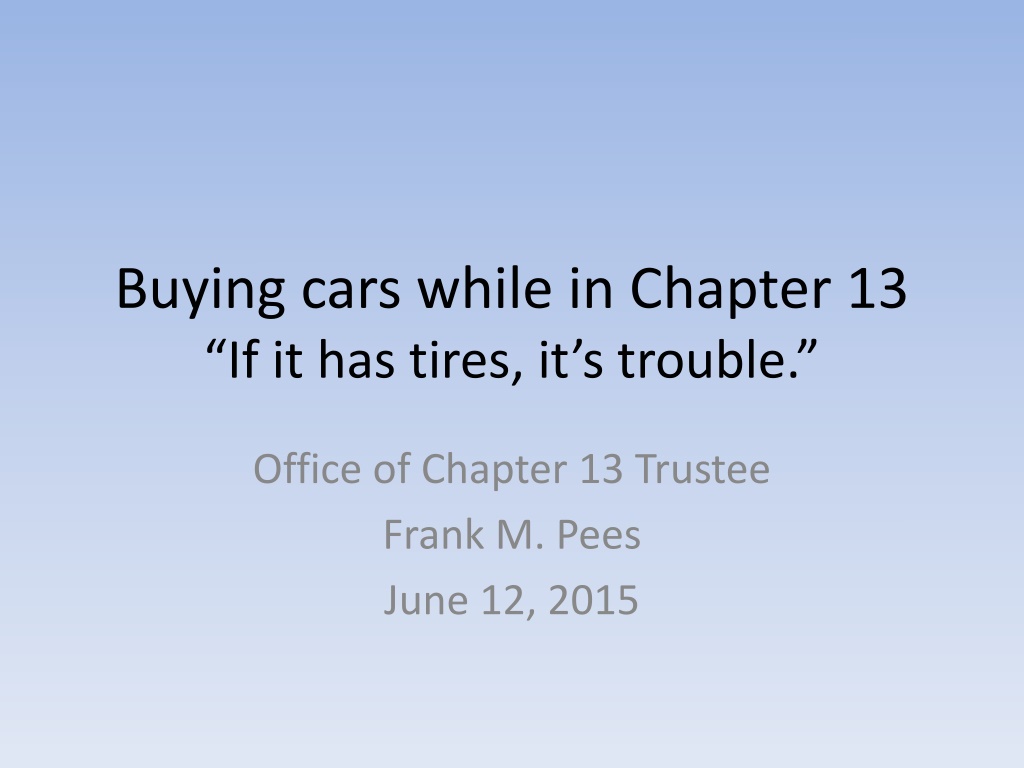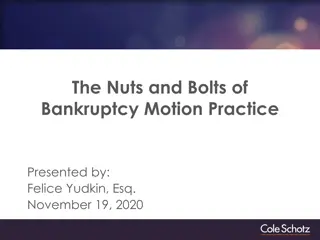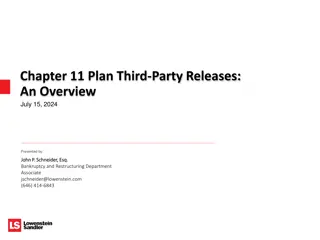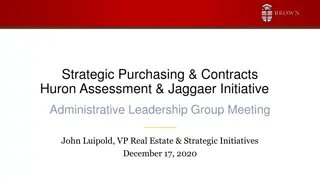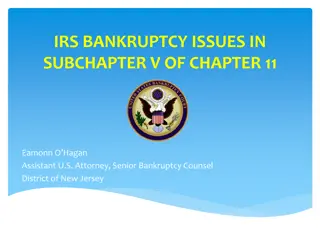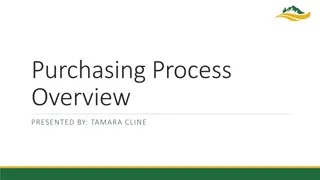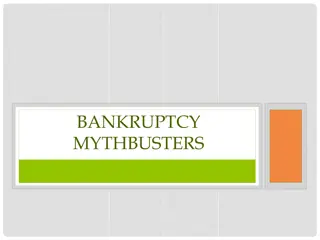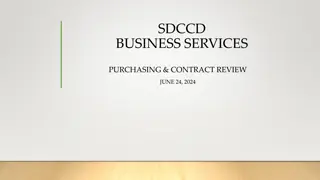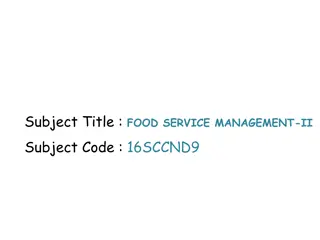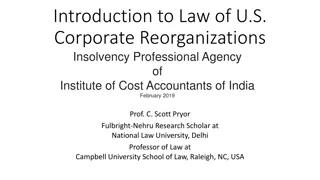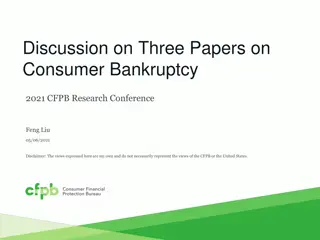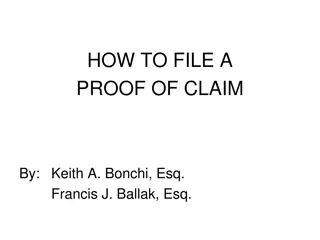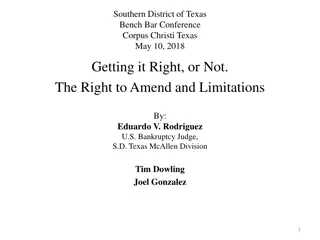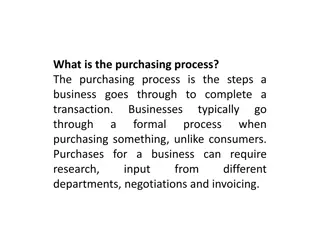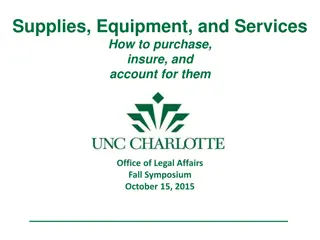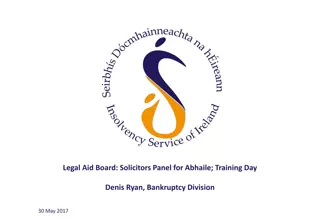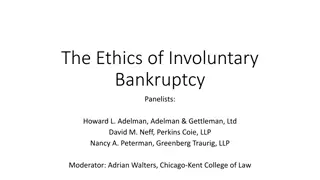Guidelines for Purchasing Cars During Chapter 13 Bankruptcy
Understanding the considerations and financial implications when buying a car while in Chapter 13 bankruptcy. Exploring factors such as the need for a new vehicle, budgeting, financing options, and realistic car choices. Emphasizing the importance of reliability over luxury during this financial phase.
Download Presentation

Please find below an Image/Link to download the presentation.
The content on the website is provided AS IS for your information and personal use only. It may not be sold, licensed, or shared on other websites without obtaining consent from the author. Download presentation by click this link. If you encounter any issues during the download, it is possible that the publisher has removed the file from their server.
E N D
Presentation Transcript
Buying cars while in Chapter 13 If it has tires, it s trouble. Office of Chapter 13 Trustee Frank M. Pees June 12, 2015
Setting the Stage for Purchasing Why is Debtor purchasing a car? Was Debtor s car totaled in accident? Are there insurance proceeds? Has Debtor s car become unreliable? Can car be repaired? Is Debtor buying an additional household car? Is an additional car really a necessity?
Setting the Stage for Purchasing What is the status of Debtor s plan? Is Debtor current in plan funding? Is Debtor s plan running long? How long has Debtor been in the plan? Does Debtor have enough room in his/her budget to pay new debt without lowering dividend? Has Debtor incurred other post-petition debt? If so, why?
Setting the Stage for Purchasing Reliable vehicle at reasonable terms Not the time for best car Debtor has ever owned. Safe, reliable vehicle to get through the plan Check sources for estimated prices
Setting the Stage for Purchasing Does Debtor need a $16,000 car? Facts to consider Age of the average car on American roads = 11.4 years (Forbes.com - June 30, 2014) Average driver puts 15,000 miles/year (business.time.com March 20, 2012) REMEMBER: Safe, reliable car to get through plan
Setting the Stage for Purchasing $16,000 loan at 15.99% over 60 months Payment is $389.00 $10,000 loan at 15.99% over 60 months Payment is $243.13 Payment is $283.35 over 48 months Payment is $351.52 over 36 months (All calculations using Bankrate.com)
Setting the Stage for Purchase A listing of cars on cars.com for $10,000: 2008 Mercury Grand Marquis (59,806 miles) 2009 Kia Sportage (85,835 miles) 2007 Cadillac DTS (62,829 miles) 2009 Jeep Patriot (84,080 miles) 2009 Mercury Grand Marquis (83,204 miles) 2013 Ford Fiesta (36,267 miles) 2010 Toyota Yaris (30,134 miles)
Setting the Stage for Purchasing Reliable vehicle at reasonable terms Trustee Pees will not approve an interest rate above 15.99%. Watch out for upsells to newer cars with higher mileage Beware of the payment plan game
Shopping for the Car Does dealer have experience with Ch. 13? Has Debtor seen and driven the desired car? Will the dealer allow Debtor to have car independently inspected? No three-day right to cancel
Shopping for the Car Will dealership provide a CarFax Report? Most dealers provide free of charge Alternatives to CarFax are available at www.vehiclehistory.gov
Shopping for the Car Watch out for the dealership s games: Do not make the decision solely on monthly payment Watch for the upsell into a newer car
Shopping for the Car Does payment amount fit into Debtor s budget? Is interest rate at or below 15.99%?
Analyzing the Deal Review terms of the deal Make and Model Price, interest, rate, term and payments Is vehicle suitable for needs of the Debtor? Has budget been analyzed to ensure purchase is feasible?
Analyzing the Deal Is there a trade-in? Does the Debtor have a clear title on the trade-in? If no clear title, will trade-in be paid in full under non-bankruptcy law?
Analyzing the Deal If the trade-in has a lien and will not be paid in full under non-bankruptcy law You need to file a Motion to Sell Free and Clear of Liens! Without an order on the Motion to Sell, the Trustee will not approve an Application to Incur Debt
Analyzing the Deal Payment on the liened traded-in vehicle must be made through the Trustee s Office
Completing the Application Are you using the Trustee s most recent Application to Incur Debt? www.ch13.org/forms
Completing the Application Is Application complete and accurate? All information required by LBR 4001-3(c)? Do terms listed in application match terms on purchase order? Is entire purchase order attached to application?
Completing the Application Is Application Complete and Accurate? Has budget been analyzed to ensure feasibility? Have you attached Amended Schedules I and J? Have you disclosed the source of any down payments?
Completing the Application Is the Application Complete and Accurate? Will any vehicles be traded-in? -Is there a lien on the vehicle to be traded in? -Will the creditor be paid in full under non- bankruptcy law?
Completing the Application Do you need a Motion to Sell Free and Clear of Liens?
Completing the Application Will plan need to be modified due to purchase? Will plan payments decrease? Will unsecured dividend decrease? If so, is proposed Motion to Modify attached to the application?
Completing the Application Have you considered adding the debt as a conduit payment? Some lenders have shown a willingness for allowing disbursements by the Trustee
Completing the Application Benefits of the conduit payment: Regular and timely payments disbursed by the Trustee Payments generally tied to a wage order One less payment for Debtor to worry about Complete record of all payments made to creditor
Conduit Process Include in application that plan will be modified to provide for a conduit payment. Once application is approved, Debtor can get the car there is no need to wait for approval of plan modification.
Conduit Process Once Debtor has possession, file a Motion to Modify providing for increase in plan payment and specifically providing for conduit car payment Motion to Modify should state that debt will be paid its contractual payment as a long-term continuing debt and is not subject to discharge
Conduit Process Motion to Modify must be served on the lender (new creditor) (not on the dealership) If lender (new creditor) objects to Motion to Modify, the Motion can be withdrawn or amended accordingly
Conduit Process Once Motion to Modify is filed, the Trustee will place hold on the monthly car payment Once Motion to Modify is granted, and POC filed by Creditor, the Trustee will be able to fully disburse on the new claim
Conduit Process NOTE: The Trustee does not object to Debtor making the first month s payment directly while the Motion to Modify is pending
Common Reasons for Denial Loan and Documentation Issues: Incomplete or illegible loan documents VIN number not provided Contract provides for GAP and/or extended warranty Interest rate exceeds 15.99% Agreement contains or similar vehicle Discrepancies between application and loan docs
Common Reasons for Denial Debtor has not provided a sufficient basis Does car being replaced actually need replaced? Is car being replaced repairable? What is cost of repair? Has estimate been provided?
Common Reasons for Denial Issues with the vehicle to be purchased Mileage is too high considering age and price of vehicle Debtor seeks to purchase a luxury vehicle Debtor is financing unnecessary aftermarket additions
Common Reasons for Denial Budget and Feasibility Issues No Amended I or J to support Monthly car payment does not fit within budget Inclusion of payment creates a budget shortfall
Common Reasons for Denial Plan Issues: Plan has accumulated an arrearage Plan is projecting longer than 60 months Debtors need to decrease dividend to finance purchase Plan no longer meeting ACP
Common Reasons for Denial Issues related to trade-in: Trade-in has a lien that is not being paid in full under non-bankruptcy law Need Motion to Sell Is payoff being sent through the Trustee? Debtors are rolling negative equity into the new loan Loan documentation does not accurately disclose trade-in information
Why Does this Matter to the Trustee? What is a fresh start?
